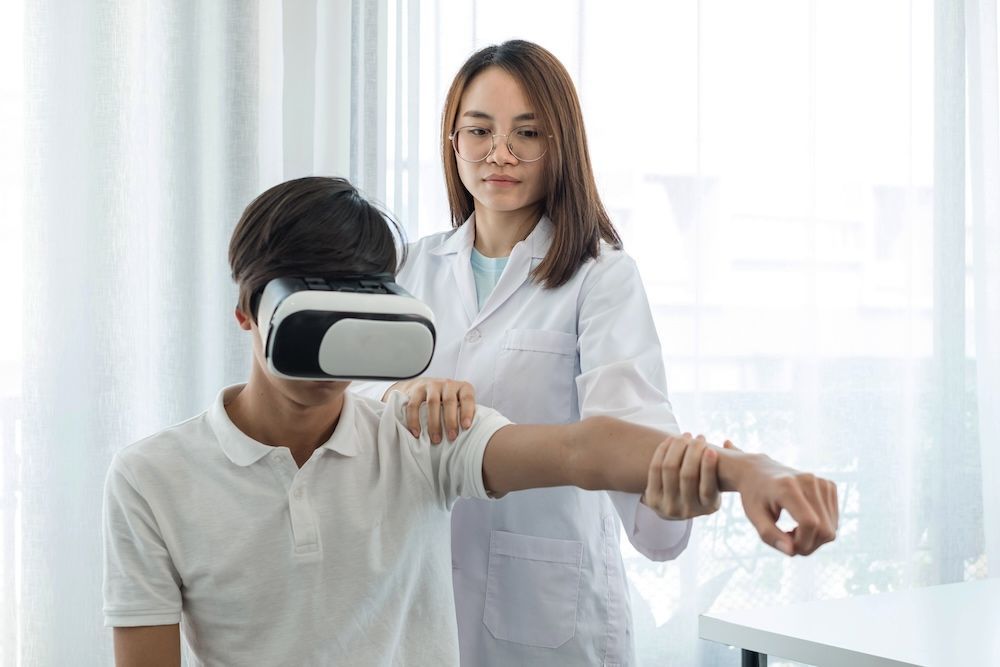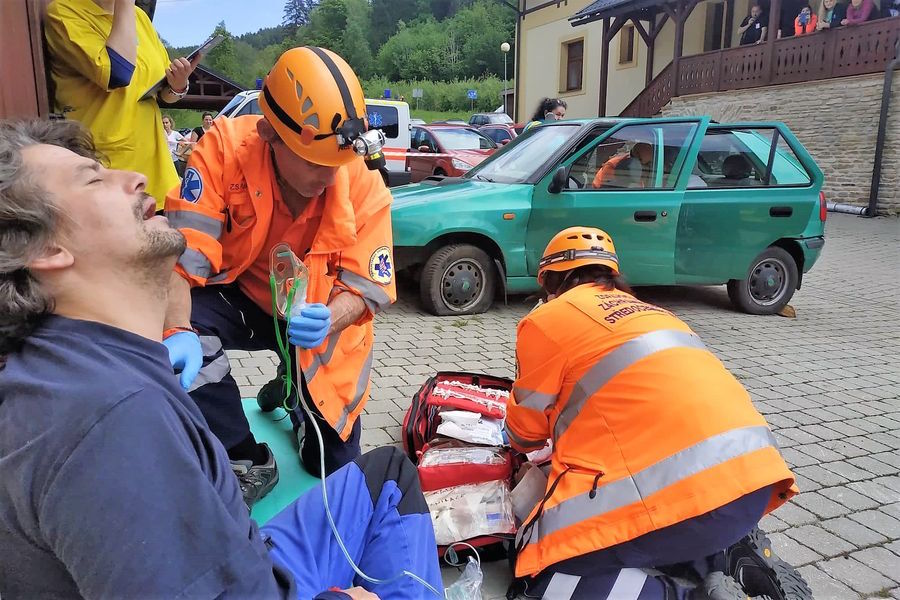Virtual Reality in healthcare simulation has grown exponentially since Covid – 19 pandemic. Healthcare Simulation has been incorporated into the Doctor of Physical Therapy curricula. According to the Healthcare Simulation Dictionary, Virtual Reality is the use of computer technology to create an interactive three-dimensional world in which the objects have a sense of spatial presence in an immersion effect. Virtual Reality is used in Healthcare Simulation environments to allow learners to experience visual stimuli delivered via computer graphics, as well as other sensory experiences. A large benefit of advancing Virtual Reality in healthcare technology is that Virtual Reality lets students learn how to perform a number of tasks and procedures involving the human body without ever having to practice on a live patient. This HealthySimulation.com article will explore the use of Virtual Reality in the Doctor of Physical Therapy curricula.
Use of Simulation in the Doctor of Physical Therapy Curriculum
The American Council of Academic Physical Therapy (ACAPT) reported results from two surveys on Simulation-Based Education in Physical Therapist Education: A Survey of Current Practice:
- 92% of programs reported some form of simulation used in their PT program
- 92% of programs reported access to a simulation center.
- The largest number of faculty primarily responsible for simulation coordination received training from their institution (48%) or were self‐taught (37%).
- 21% of faculty responsible for simulation reported having no training at all.
- 86% of the responding PT programs included at least three SBLEs during the course of their program.
- 69% of programs reported plans to expand the use of simulation in their PT program.
- The most commonly identified barriers to implementing SBLEs included time-related to faculty availability and schedule, as well as space/facility constraints and curricular constraints.
- Augmented reality, virtual reality, and computer‐based simulations are in limited use at this time.
- Standardized patients were used by a majority of respondents.
The ACAPT has Simulation Resources available for Physical Therapy programs. On this resource page, simulationists have access to a simulation scenario library for ACAPT members, an ACAPT simulation scenario template, and a video on how to use the template.
ACAPT contributed to the 2022 Healthcare Simulation Standards of Best Practice from the International Nursing Associate for Clinical Simulation and Learning (INACSL). The website offers a free Simulation 101 recorded session to help address the gap identified in the ACAPT survey for the simulation professional development opportunities for faculty members teaching in the PT program.
Research to Support Virtual Simulation in the Doctor of Physical Therapy Curriculum
Connelly Ortega et al., (2021) Digital and blended curriculum delivery in health professions education: an umbrella review with implications for Doctor of Physical Therapy education programs: This study identified that digital strategies were found to be at least as effective as traditional strategies for learner satisfaction, attitude, knowledge, and skill. The evidence supports the incorporation of digital strategies as an adjunct to or replacement for portions of a traditional curriculum. The evidence suggests that physical therapy education programs should not abandon all of their recently implemented digital strategies now that the pandemic has ended.
Stockert et al. (2022) Simulation-Based Education in Physical Therapist Professional Education: A Scoping Review: This review revealed a significant increase in the literature describing SBE with PT students. Simulation was used to address learning objectives across a variety of content areas and clinical settings. Communication skills were the most common objectives for the simulation. Limited use of SOBP, published in 2016, was reported, and the use of author-generated outcome measures without validation was common. This review states the limited use of standards of best practice and validated outcome measures and requires further investigation and awareness to advance SBE in PT programs.
HTC Vive Shares Virtual Reality Opportunities for Physical Therapy
On the HTC Vive website is the article “Virtual Reality Physical Therapy: A New Frontier for Healing and Recovery“. Physical therapists are increasingly turning to virtual reality (VR) and extended reality (XR) technology to help patients recover faster and decrease adherence rates. With VR/XR, patients are happier and more engaged during their sessions, and therapists can collect and track more data points to measure rehabilitation improvements. These strengths combine to make VR/XR therapy a crucial element in expanding treatment beyond the therapy room, and are why VR/XR is rapidly becoming the future of physical therapy.
“You can transport anyone from a traditional therapy room to anything you want it to be,” said Dave Rawlins, Chief Operating Officer of MyndVR, a leading digital therapeutics company for senior care. “In our case, we have an application called ‘Butterflies,’ which transports a person from the therapy room to a beautiful open meadow. The user has a net, and they can catch butterflies with the net.”
By creating a different context for patients, virtual and extended reality transforms strenuous work into play and allows users to visit worlds beyond the confines of their typical therapy sessions. This, in turn, makes patients more likely to return to physical therapy, makes them more engaged, and improves the effects of each session. According to a profile in The New York Times , patients who undergo VR/XR therapy tend to exercise longer, put more effort into their session, and even experience a decreased awareness of pain compared to traditional therapy sessions
View the LEARN CE/CME Platform Webinar How to Select the Right VR Headset for Healthcare Simulation Training to learn more!
Download your free copy of the HTC Vive XR Training Solutions for Healthcare eBook here! From the ebook, clinical simulation champions will learn valuable lessons provided by VR solution developers and medical professionals, including:
- How to account for the lack of standardization of healthcare equipment.
- Which stakeholders to involve to help build the best possible VR solution?
- Navigating the industry’s stringent security requirements to speed up approval times.
- And more!
Learn More About the Freely Available Virtual Simulation Educator’s Toolkit!







